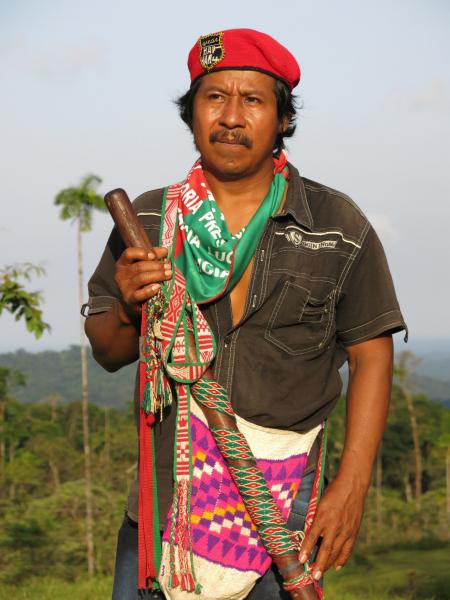P { margin-bottom: 0.21cm; direction: ltr; widows: 2; orphans: 2; }A:link { color: rgb(5, 99, 193); }
 Since the arrival of the oil industry in the Colombian Amazon, multinationals have been causing a rupture with the traditional ways of living of the Nasa indigenous. Nothing is different in the in the department of Putumayo, where hooded and armed men attacked the indigenous Community of Bellavista at the beginning of this month. The Canadian multinational Gran Tierra has been showing its interest in the local oil reserves.
Since the arrival of the oil industry in the Colombian Amazon, multinationals have been causing a rupture with the traditional ways of living of the Nasa indigenous. Nothing is different in the in the department of Putumayo, where hooded and armed men attacked the indigenous Community of Bellavista at the beginning of this month. The Canadian multinational Gran Tierra has been showing its interest in the local oil reserves.
Around 1300 of the 186 thousand-strong indigenous Nasa population of Colombia live in the southern department bordering with Ecuador.
On the 7th of May, a troubling act of violence was displayed when at 20h55 in the evening, around 15 hooded men arrived with a taxi and various motorbikes. The men were armed with long-range weapons and opened fire on the communal building, burning it down to the ground. A grenade was also thrown and exploded between parked cars. In addition to the house, two cars and three motorbikes were burned down.
The five families who are living in the village, fled into the surrounding woods when the armed men took shots at the villages´ buildings, where the same families had been present. Gílberto Muchicón, coordinator of the indigenous guard, speaks about the intense situation: ¨The kids and the people started running in all directions when shots were fired at our houses. The people woke up in the mountains where the y were hiding out the next morning¨. What is more than worrisome, is that the public forces were alarmed during the attack, but never showed up.
y were hiding out the next morning¨. What is more than worrisome, is that the public forces were alarmed during the attack, but never showed up.
Even five days later, the community hadn´t been visited by the public forces. There were representatives of the United Nations, the NGO Accíon Contra el Hambre (Action Against Hunger) and an official of the Personería (an office of the Public Prosecutor). Still, the absence of the army is very strange, the region counts with a high presence of the public forces, mainly in order to protect the interests of the operations of Gran Tierra. Gran Tierra has a military battalion that serves for the protection of their projects nearby.
Even though there is no official knowledge of this, there are a few suspicions. According to Gíberto Munchicón, on the 6th of April, a pamphlet was circulated in the region by a group called ¨LA MANO INVISIBLE – COMANDOS URBANOS¨ (the invisible hand – urban commandos). The pamphlet basically threatened all opposition by farmer groups, indigenous leaders and social organizations against the plans of the country’s current president, Juan Manuel Santos.
At the end of 2014, the indigenous community resisted against seismic activities by Gran Tierra in the region, this because of the risk it imposes on water sources and the high ecological variety in the region. As a result of their opposition, the local environmental authority CorpoAmazonía suspended seismic activities of the oil industry in their region (for 180 days).
According to José Antonia Jajoy, a board member of CorpoAmazonia, the decision was based on irregular activities on unconsulted territory. Gran Tierra had consulted with communities on the lower part of the zone, while the company began perforations on the higher parts, close the community of Bellavista which opposes the project and its possible future impact.
The interest of Gran Tierra in the region, causes suspicion around the violent acts. Gran Tierra has been mentioned before in relation to human rights violations in Putumayo.
 According to the community leaders, Gran Tierra has been conducting false consultations with indigenous outside of the community, they condemn the company and its strategies to ´divide and conquer´. This is backed up by José Antonio Jajoy who says: ¨Those consultations which they organize in the region, are consultations under pressure. They manipulate, reach out to communities who do not have a lot of capacity and therefore end up firming derisory contracts. ¨The consultations simply fail to comply with legal requirements.¨
According to the community leaders, Gran Tierra has been conducting false consultations with indigenous outside of the community, they condemn the company and its strategies to ´divide and conquer´. This is backed up by José Antonio Jajoy who says: ¨Those consultations which they organize in the region, are consultations under pressure. They manipulate, reach out to communities who do not have a lot of capacity and therefore end up firming derisory contracts. ¨The consultations simply fail to comply with legal requirements.¨
In recent years, marches have been organized against Gran Tierra, the opponents (mainly indigenous and unions) are facing state criminalization and increasingly have been targeted by (para-)military groups since the arrival of Gran Tierra. Acknowledging that the zone around the Nasa community of Bellavista has not had any problems with guerrilla groups in the last years and currently does not have any local conflicts besides the actual problems with Gran Tierra, there is a high suspicion that Gran Tierra directly or indirectly has caused the violent acts on Wednesday the 7th of May.
There is fear it was not the last violent act in the region, as José Antonio Jajoy mentions: ¨The people are really worried. The company will keep insisting on the project, threats will return.¨